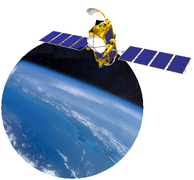News
30.04.2008 14:27 Age: 17 yrs
Altimetry applications in videos: Beginning of life
Category: Website updates
The OSTM/Jason-2 altimetry satellite left Toulouse (France) by night between the 28th and 29th April 2008 on its way to the launch pad at the military base in Vandenberg, California (USA). Once the satellite payload has been integrated on a Delta II launch vehicle and covered with the fairing, it will undergo the Flight Readiness Review for a launch on 20th June, 2008. Designed and built jointly by Cnes, Eumetsat, Nasa and Noaa, the OSTM/Jason-2 will begin observing from Space, thus continuing the missions of its two predecessors, Topex/Poseidon (1992-2006) and Jason-1 (launched in 2001).
The OSTM/Jason-2 will reach its final orbit at an altitude of 1,336 km with an inclination of 66°. The launch phase will start at H0-10 h and last until the satellite separates from the launcher, after about a 55-minute flight. It will then turn erratically on all axes like an irregularly-shaped stone, until an automatic sequence of the attitude control sequence kicks in to stabilize the satellite in its orbital reference frame. Then, the instruments will be automatically released and deployed. When the solar arrays spread out the satellite's geometric configuration will change, which in turn, will reduce the speed at which it spins on its axis. At this stage the satellite will be in what is known as 'barbecue mode', while its different sides are alternately exposed to the sunlight. However there is more to come in this early phase of the satellite's life: the Proteus platform elements will be activated and the payload instruments powered-up by remote commands from the project team on the ground. All these delicate operations will be performed while the satellite is within reach of a ground station. In particular, the satellite control centre will keep the instruments pointing at the geodetic nadir.
During the launch phase, the OSTM/Jason-2 will be placed on an orbit below that of Jason-1 but this will be adjusted after about one week so that its and phased so that its operational orbit is ahead of or behind Jason-1 by one to ten minutes. This tandem formation flight of the two satellites will last approximately nine months to enable the Principal Investigators to make a thorough comparison and correlation of the OSTM/Jason-2 and Jason-1 engineering parameters and altimetry results. After a last review, Jason-2 will be cleared for the operational phase of its ocean observation mission and will start delivering a continuous supply of data.
Jason-2's schedule from its departure from Toulouse (France) to its launch from Vandenberg (California, USA) the 20th of June 2008, with some details about this delicate operation of the launch phase.
 See the video Beginning of life: flash (9 Mo) or mpeg (38 Mo)
See the video Beginning of life: flash (9 Mo) or mpeg (38 Mo)
The OSTM/Jason-2 altimetry satellite left Toulouse (France) by night between the 28th and 29th April 2008 on its way to the launch pad at the military base in Vandenberg, California (USA). Once the satellite payload has been integrated on a Delta II launch vehicle and covered with the fairing, it will undergo the Flight Readiness Review for a launch on 20th June, 2008. Designed and built jointly by Cnes, Eumetsat, Nasa and Noaa, the OSTM/Jason-2 will begin observing from Space, thus continuing the missions of its two predecessors, Topex/Poseidon (1992-2006) and Jason-1 (launched in 2001).
The OSTM/Jason-2 will reach its final orbit at an altitude of 1,336 km with an inclination of 66°. The launch phase will start at H0-10 h and last until the satellite separates from the launcher, after about a 55-minute flight. It will then turn erratically on all axes like an irregularly-shaped stone, until an automatic sequence of the attitude control sequence kicks in to stabilize the satellite in its orbital reference frame. Then, the instruments will be automatically released and deployed. When the solar arrays spread out the satellite's geometric configuration will change, which in turn, will reduce the speed at which it spins on its axis. At this stage the satellite will be in what is known as 'barbecue mode', while its different sides are alternately exposed to the sunlight. However there is more to come in this early phase of the satellite's life: the Proteus platform elements will be activated and the payload instruments powered-up by remote commands from the project team on the ground. All these delicate operations will be performed while the satellite is within reach of a ground station. In particular, the satellite control centre will keep the instruments pointing at the geodetic nadir.
During the launch phase, the OSTM/Jason-2 will be placed on an orbit below that of Jason-1 but this will be adjusted after about one week so that its and phased so that its operational orbit is ahead of or behind Jason-1 by one to ten minutes. This tandem formation flight of the two satellites will last approximately nine months to enable the Principal Investigators to make a thorough comparison and correlation of the OSTM/Jason-2 and Jason-1 engineering parameters and altimetry results. After a last review, Jason-2 will be cleared for the operational phase of its ocean observation mission and will start delivering a continuous supply of data.
Further information:
- Missions : <link internal-link>Jason-2
- Cnes, <link http: www.cnes-multimedia.fr dossiers cnes_video index.html external-link-new-window>Jason-2 la continuité avant tout (video in french)
- Eumetsat, <link http: www.eumetsat.int home main media press_releases external-link-new-window>Jason-2 arrives in California
- JPL, <link http: www.jpl.nasa.gov news external-link-new-window>Ocean Survey Spacecraft Arrives at Launch Site





